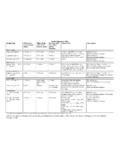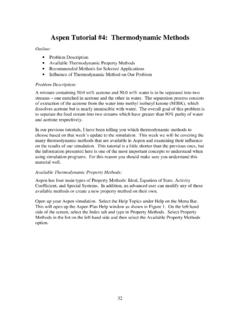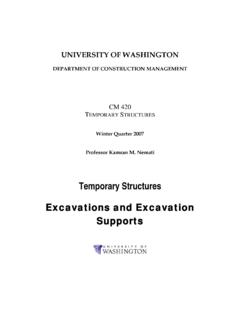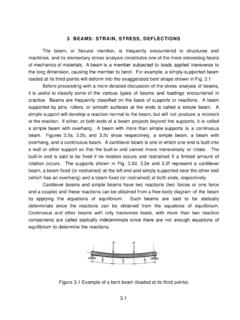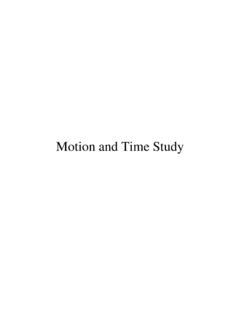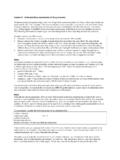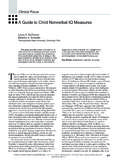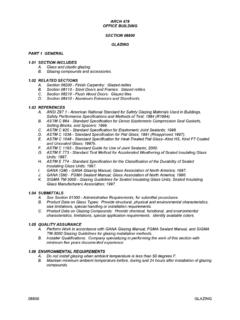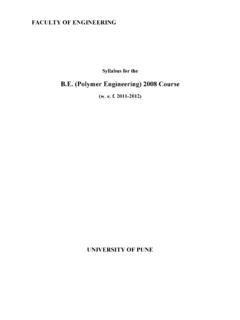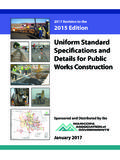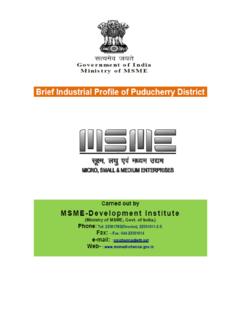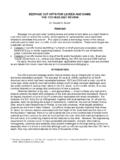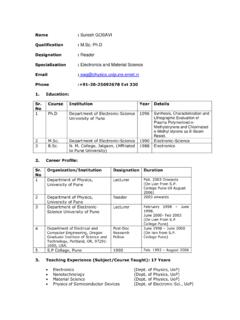Transcription of Overney Lecture Part 1 v4 - UW Courses Web Server
1 Nanoparticle Synthesis Top-Down Bottom-Up via Attrition / Milling Via - Pyrolysis Involves mechanical thermal cycles - Inert gas condensation Yields - broad size distribution - Solvothermal Reaction (10-1000 nm) - Sol-gel Fabrication - varied particle shape - Structured Media or geometry - impurities Application: - Nanocomposites and - Nano-grained bulk materials Ren Overney / UW Nanothermodynamics and Nanoparticle Synthesis NME 498A / A 2010. part 1: Nanoparticle Synthesis Bottom Up Synthesis Phase Classification: I. Gas (Vapor) Phase Fabrication: Pyrolysis, Inert Gas Condensation, . II. Liquid Phase Fabrication: Solvothermal Reaction, Sol-gel, Micellar Structured Media Ren Overney / UW Nanothermodynamics and Nanoparticle Synthesis NME 498A / A 2010.
2 part 1: Nanoparticle Synthesis Bottom Up Synthesis Phase Classification: I. Gas (Vapor) Phase Fabrication: Pyrolysis, Inert Gas Condensation, . II. Liquid Phase Fabrication: Solvothermal Reaction, Sol-gel, Micellar Structured Media Ren Overney / UW Nanothermodynamics and Nanoparticle Synthesis NME 498A / A 2010. part 1: Nanoparticle Synthesis Homogeneous Condensation Cluster free energy: negative volume term positive surface term 4 3 Driving Force: GV. G = r Gv + 4 r . * 2. 3 Bulk free energy difference between old and new phase G, Gibbs Free Energy GV. CL* CL CS. Concentration: CL* Solution in Equilibrium Finney, Finke / J.
3 Coll. Inter. Sci. 317 ( 2008 ) 351 374 CL Supersaturated Solution CS Solid phase Ren Overney / UW Nanothermodynamics and Nanoparticle Synthesis NME 498A / A 2010. part 1: Nanoparticle Synthesis Growth Steps and Limitations Steps Generation of growth species ( , reduction from minerals). Diffusion from bulk to the growth surface Adsorption = (n ) . Growth Modes: Surface growth ( growth modes) FM. VM. SK. Limitation 0. 1 2 3 4 5 6 7 8 9 10. Diffusion-limited growth number of monolayers Size-limited (Oswald ripening). Transport-limited growth Ren Overney / UW Nanothermodynamics and Nanoparticle Synthesis NME 498A / A 2010.
4 part 1: Nanoparticle Synthesis Vapor Phase Growth Growth rate of vapor condensation: Flux from gas kinetic theory p p = pV pe R = ANP ;. 2 mk BT Spherical NP: ANP = 4 d NP.. condensation coefficient (between 0 and 1). ANP .. surface area of condensate (nanoparticle NP). m .. mass of gas molecule kB .. Boltzmann constant, and T absolute temperature Driving force: pressure difference p pV .instantaneous vapor pressure Pe . local equilibrium pressure at the growing cluster Ren Overney / UW Nanothermodynamics and Nanoparticle Synthesis NME 498A / A 2010. part 1: Nanoparticle Synthesis Vapor Phase Synthesis Mechanism and Effectiveness (i) precursor vaporization (typically involves a catalyst).
5 (ii) nucleation, and (iii) growth stage Effectiveness demands: - simple process - low cost Aerosol Spray Methods ( , Spray Pyrolysis). - continuous operation - high yield Ren Overney / UW Nanothermodynamics and Nanoparticle Synthesis NME 498A / A 2010. part 1: Nanoparticle Synthesis Vapor Phase Synthesis Methods Discussed are: Pyrolysis (Spray Pyrolysis). Spray pyrolysis is the aerosol process that atomizes a solution and heats the droplets to produce solid particles Inert Gas Condensation Tube Furnace (~500-1000 oC). (Chemical Vapor Deposition) inert gas inlet HC Gas (CnHm). Ren Overney / UW Nanothermodynamics and Nanoparticle Synthesis NME 498A / A 2010.
6 part 1: Nanoparticle Synthesis Vapor Phase Synthesis Spray Pyrolysis solid particle growth within droplet can be use only as a dryer or also as a reactor production of droplets and their dispersion into the gas F. Iskandar, Adv. Powder Techn. 20 (2009) 283. Ren Overney / UW Nanothermodynamics and Nanoparticle Synthesis NME 498A / A 2010. part 1: Nanoparticle Synthesis Vapor Phase Synthesis Spray Pyrolysis Atomizer Type Furnace Type Precipitator Type F. Iskandar, Adv. Powder Techn. 20 (2009) 283. Ren Overney / UW Nanothermodynamics and Nanoparticle Synthesis NME 498A / A 2010. part 1: Nanoparticle Synthesis Vapor Phase Synthesis Spray Pyrolysis Droplet Evolution Evaporation Precipitation Drying Decomposition Sintering Messing et al, J.
7 Am. Ceram. Soc., 1993. If the solute concentration at the center of the drop is less than the equilibrium saturation of the solute at the droplet temperature, then precipitation occurs only in that part of the drop where the concentration is higher than the equilibrium saturation, , surface precipitation. Ren Overney / UW Nanothermodynamics and Nanoparticle Synthesis NME 498A / A 2010. part 1: Nanoparticle Synthesis Vapor Phase Synthesis Spray Pyrolysis Precipitation Control Messing et al, J. Am. Ceram. Soc., 1993. Che et al, J. Aer. Sci., 1998. Ren Overney / UW Nanothermodynamics and Nanoparticle Synthesis NME 498A / A 2010.
8 part 1: Nanoparticle Synthesis Vapor Phase Synthesis Spray Pyrolysis: Ga(NO3)3 and GaN. Goal: Fabricate GaO3 with - narrow size distribution, and - homogeneous composition Ga(NO3)3 + H2O. and LiCl GaN nanoparticles of I nm diameter T. Ogi et al., Adv. Powder Technology 20 (2009) 29. Ren Overney / UW Nanothermodynamics and Nanoparticle Synthesis NME 498A / A 2010. part 1: Nanoparticle Synthesis Vapor Phase Synthesis Spray Pyrolysis: Porous Silica NP. Pyrolysis: Generate droplet mixtures of Primary Particles with Polymer Particles F. Iskandar / Advanced Powder Technology 20 (2009) 283. Ren Overney / UW Nanothermodynamics and Nanoparticle Synthesis NME 498A / A 2010.
9 part 1: Nanoparticle Synthesis Vapor Phase Synthesis Porous Silica NP Application: Colloidal Damper Hydraulic Damper (oil is working fluid, energy is dissipated via orifice flow). Hydrophobized porous silica particle (outside and inside) suspended in water as the working fluid Colloidal Damper Advantage: Little heat generation in colloidal damper. Suciu et al., J. Coll. Interf. Sci., 259 (2003) 62. Ren Overney / UW Nanothermodynamics and Nanoparticle Synthesis NME 498A / A 2010. part 1: Nanoparticle Synthesis Vapor Phase Synthesis Inert Gas Condensation (IGC). Entails the evaporation of a course substance in an inert gas atmosphere.
10 Methods: Cold Finger - Physical Vapor Deposition (PVD). (no catalytic interaction). - Chemical Vapor Deposition (CVD). (with catalytic interaction). Tube Furnace (~500-1000 oC). inert gas Evaporation Sources inlet HC Gas (CnHm). Catalytic Surface F. Iskandar, Adv. Powder Techn. 20 (2009) 283. Ren Overney / UW Nanothermodynamics and Nanoparticle Synthesis NME 498A / A 2010. part 1: Nanoparticle Synthesis Vapor Phase Synthesis Coalescence and Agglomeration One of the big challenges in condensation growth is that the particles coalesce and agglomerate. A solution proposed: Use of a gas jet stream. A jet stream of carrier gas positioned above the evaporation sites is used to carry away the metal vapor.

